
© Foteini Christofilopoulou. (Click image for larger version)
northernballet.com/victoria
www.cathymarston.com
Interview: 16 February 2019, at London’s Royal Opera House.
Cathy has been working these last few weeks at Northern Ballet in Leeds, creating her new full evening Victoria for the company and we wanted to find out more, also catch up on other commissions and discuss just how she works creatively and manages to juggle it all so effortlessly…
BM: You premiere Victoria on the 9 March at the Grand Theatre in Leeds – where did the idea spring from?
CM: David Nixon (Northern Ballet Artistic Director) – he had the idea. He emailed me, maybe 18 months ago – one if his famous one liner emails “Will you do Victoria?” (or something to that effect!) And I hadn’t watched the TV series, so I binge watched it and I was about half way through on the Saturday, like the next day, and he said “Well!?” {there is much laughing as she tells it} So I said, “I’m only half-way through, I’m up to Lord M (Lord Melbourne), but YES!”
So yes, it was his idea, but it really only came with a title. Obviously, he knew that I know the company and he knows me, so there are things that don’t need to be discussed anymore. It was very free in terms of approach – I could go in whichever direction I wanted to. So, I sought out a team straight away, because it came at relatively late notice (18 months – and I was fairly well booked for some other things). For the first time I am working with Uzma Hameed. Usually my dramaturg is Edward Kemp. He and I were doing Lady Chatterley at that time (for Les Grands Ballets Canadiens de Montréal) and another project (that I can’t announce), so I looked for anther dramaturg. And Uzma was recommended – she did Woolf Works with Wayne McGregor – she’s also a writer and a director – a theatre person. Jenny Tattersall (Cathy’s assistant) had worked with her on Woolf Works and she and some others thought that we’d really “click”. And so we met, it felt good, and I invited her to be part of it. Which has been a really interesting process because, of course, I’ve been working with Edward (Kemp) for 15 years.

© Guy Farrow. (Click image for larger version)
Tell us about Victoria, the plot of Victoria, the ballet, and how you developed it?
We (Uzma and I) both did independent research for 6-8 weeks and we were emailing a little bit along the way and I think I’d identified, without saying “this is it”, but I think we both knew this particular direction was the seed of the idea. And then she came over to Bern for a week and we thrashed it out, you know we had post-its everywhere.
The way in for me turns out to be a little nugget that was in one of the massive biographies. Apparently on the night that Albert died, obviously Victoria is completely devastated, and so legend has it, she rushed to the room of her ninth child, Beatrice, who was four at the time, gathered her up in her arms, wrapped her in Alberts dressing gown and took her to bed with her – and essentially never let go. So, while all of the other children were sent off to create this royal dynasty in different arranged marriages around Europe, Beatrice was very much kept at her mother’s side – forever. Which wasn’t that unusual at the time – for that to be the role of the youngest daughter. But it was an interesting role in this situation because it wasn’t any old mother, this was Queen Victoria and she was very demanding. And Beatrice didn’t seem to be the rebel that some of her sisters were and really committed to this role.
Although Victoria forbade any discussion of marriage and babies around Beatrice, at one-point Beatrice did meet a man, at a wedding and behind her mother’s back. It was Henry of Battenberg, who we call Liko (that was his nickname) and they fell in love. And I think by this point she was in her late 20s and so kind-of getting “past-it” and this was her last chance, if you like. And she told her mother that she wanted to get married and Victoria was furious, and they didn’t speak for seven months – they lived together without speaking.
Because Beatrice, who was known as the shy princess, stood her ground, finally Victoria was persuaded to allow the wedding on the condition that they lived with her. So, for ten years Beatrice and Liko lived with Victoria and they had four children. But Liko, very athletic and ex-military, obviously got more and more frustrated in the royal household and re-joined the military after ten years. And then, on his way out to Africa, he got sick and died. And so, Beatrice then became, in every way, an echo of her mother – she is the widow in black, along with her mother. And she stayed with her mother forever after, often deputising and doing the speeches for her mother.
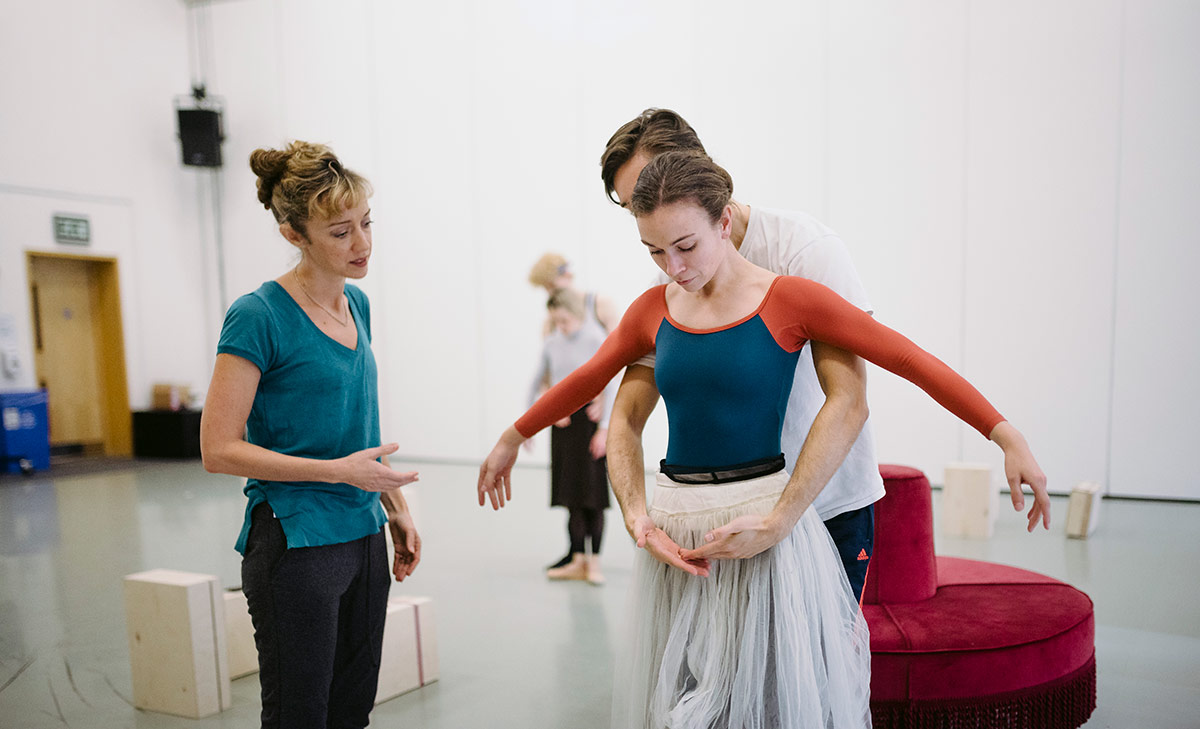
© Drew Forsyth. (Click image for larger version)
So, she was really a second Victoria. And then when Victoria died, or just before she died, she entrusted Beatrice with her diaries – there were 122 of them. Victoria wrote a huge amount every day and it was Beatrice’s role, or so she felt, to bring these diaries to a point fit for publication. And she went about this over 30 years, rewrote the lot but edited them so they got reduced to 111. And key things, that of course everybody is interested in – like what was the relationship with John Brown – they are not in there! The 7 months in which Victoria didn’t speak to Beatrice is not mentioned either – which is just simply not possible! Having edited them she burnt the originals.
It all struck me as an incredibly interesting story both from an historical perspective, but also just in terms of human relationships – you get “My Mother the Queen” through a daughter’s eyes. And this daughter, who sort of became her mother in so many ways, is a completely unreliable witness, but that makes it interesting from my point of view because there are a lot of facts that we know, but there’s a lot of gaps too, that we can fill through our imagination and having this frame. At that point I wasn’t really sure if I liked Victoria. I’ve become more sympathetic to her, actually, along the way. But there’s so many ways to look at her and her reign and what happened – both rosy and not. And I wanted someone who we could follow and feel for throughout the piece. And it felt like by looking at her through Beatrice’s eyes in this quite episodic way, we would be able to leap-frog through these various periods in her life but still have a thread, so it wouldn’t feel disconnected because Beatrice is emotionally taking us through it.
It’s a fascinating story and backstory, so how do you start to tell it?
It’s not uncomplicated because it starts on the point of Victoria’s death. So, we see Victoria die and the funeral and then it sort of lives in this enormous archive of red books, because Victoria wrote in red diaries and of course the first thing you do, in my opinion and Uzma’s opinion, would be to remember the past. So, Beatrice goes back to her youth and remembers her mother as the widow in black with John Brown – because that was the man in her mother’s life at that point. In act one we live through the second half of Victoria’s life, until the point where Beatrice has met Liko, they get married, they live with the mother, he goes away, dies and then there is this crisis that comes when Victoria puts this black dress on Beatrice and Beatrice realises “Oh my God, I’ve became my mother”. And how could that have happened, and I don’t want to be that, and who was my mother, and she has a hissy fit.
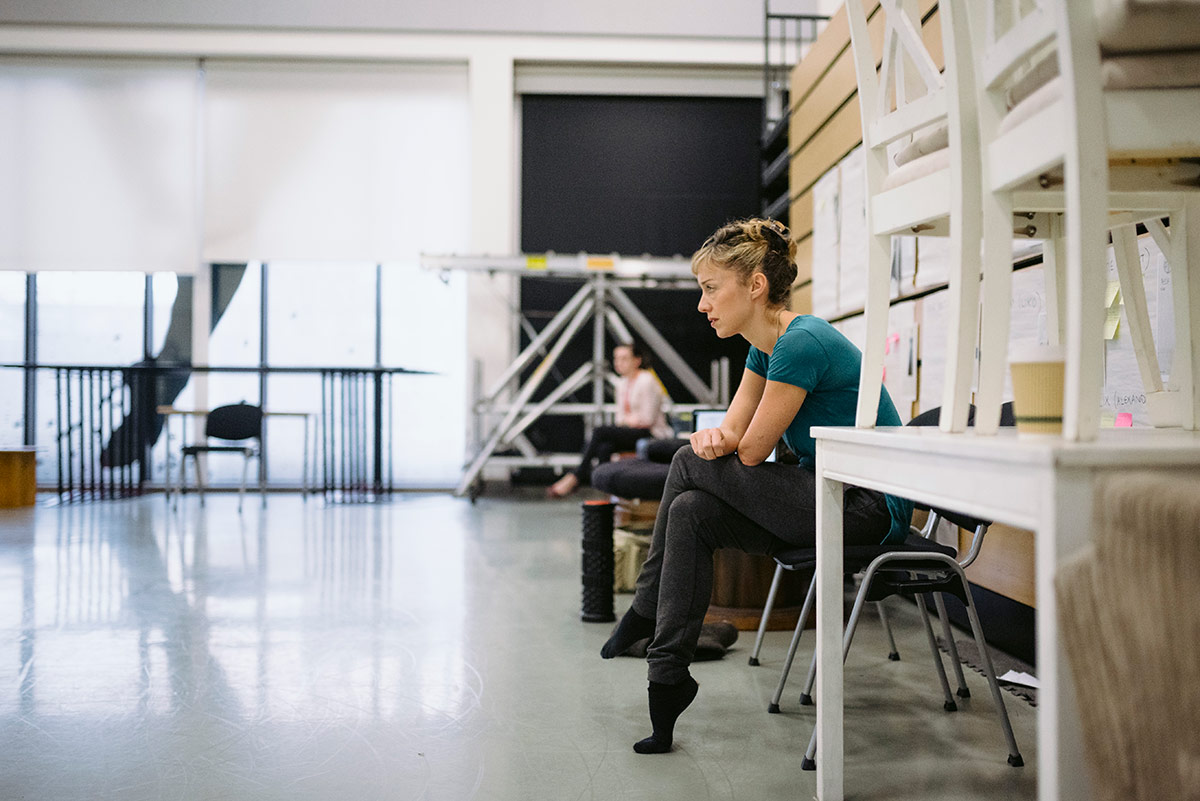
© Drew Forsyth. (Click image for larger version)
Then in Act 2, the red books are all around the floor, she then goes back to find out who really was her mother and she peels off this big black dress/thing and finds the woman in a white nighty, the 18-year-old, who was just about to become queen. She discovers who her mother really was, or how she had become this woman that we remember.
And it’s really emotional by the end – we choreographed the last scene this week and twice we’ve had tears. I don’t know if it resonates more because you know you are doing a person who actually lived. This might not have been exactly what happened, but you have to believe that that’s how it probably happened. Maybe it makes it live more inside you for that reason, I’m not sure. But it feels like for all of us, for the Victoria’s and the Beatrice’s I think, we really do now feel for both of them. So, we’ve done the journey that Beatrice has done, we are able to love Victoria and understand Victoria having gone on this journey that Beatrice obviously went on. It all feels rather strange, wonderful and connected.
What about music and design for Victoria?
For music I obviously got Philip Feeney on-board, who I adore – he’s brilliant! For the first time it’s all original, first time for us together. And he can do the lot in terms of styles.
There are a few scenes in which I asked him to suggest the 19th century, to locate us in time. And then, because it sits in this archive world, there’s sort of 2 narratives going on – there’s the Victoria world and then there the Beatrice journey that she’s going on – so there’s a bit more of a minimalist feel for that. And then, of course, there’s the emotional world that’s not about period at all. You know, there are things like Albert’s solo and when they first meet – they played piano – they played Mendelssohn together. We actually looked to quote some Mendelssohn, but we couldn’t find anything that felt exactly right, so he’s come up with some Feendelssohn!

© Steffen Aarfing. (Click image for larger version)
And then I brought on board Steffen Aarfing who did the Dangerous Liaisons set and costumes (in Copenhagen) and I met originally on Król Roger at the ROH. Northern really like him because it’s not flats for a set, there’s a sort of structure to these huge bookcases. He designed it inspired by a library somewhere in Scandinavia and then he went to Leeds and while having lunch discovered the circular Corn Exchange – it has exactly the look he created! And actually, the Victoria poster is that – they’ve rubbed out all the shops and photoshopped it a bit, but it’s the staircase and the round interior of the Leeds Corn Exchange.
What’s it been like working with Northern Ballet this second time?
The company have been incredibly supportive. I love the dancers – they are so with me – it’s a really good place to create for me now, because you don’t spend weeks getting to know each other. They are so onboard with the narrative, they all really research themselves. And they are efficient – they are used to working hard, even with all these different casts, they are very on-it. And they do take ownership of the piece and ideas and, I think, especially on the back of Jane Eyre now, there’s a huge belief in what we can do together.
So, who is leading out the first night of Victoria?
Abi is the first cast (Abigail Prudames) and Jo Taylor (Joseph Taylor) is Albert. Abi, as Victoria, is the biggest part – she hardly goes off. Pippa Moore is the old Beatrice. Which I’m so happy about because it’s her last thing – at 44 she’s retiring. It’s funny – on the first day she noted that after a career of playing either children or grandmothers she’s finally, on her last performance, gets to play somebody who is actually her own age! She’s fantastic – she is such a good actress. And she still can do so much, body-wise. And there’s two very nice casts covering. Mlindi Kulashe is John Brown. Sean Bates is Liko which is quite a big part. And Javier Torres was going to be Lord M, but he is injured. I hope he will be back for Sadler’s Wells, but he’s not going to be able to dance the premiere which is a shame.
Is there anything else we should know about Victoria?
That’s pretty much the gist of it. I suppose the main thing is to talk about the Beatrice point of view, because I’m trying to prepare people not to come in expecting the TV series. Or Mrs Brown or any number of the adaptations or films that have been inspired by the story. It’s a different perspective. There is a book, there is a biography of Beatrice called “The Last Princess” by Matthew Dennison and it’s not in any way a reworking of that book, but it’s been very helpful to us, obviously, to have a biography of her, and he’s been very sweet in the last couple of weeks – he’s been interviewed for the programme and actually he interviewed me for the Telegraph – I asked him to do an interview in reverse – which was quite nice. But yes, I’m trying to explain that this is going to be a different perspective and hopefully an interesting and compelling one.
What happens on the day of a premiere – do you have any set routines and do you get nervous?
Well sadly my family won’t be there this time. The last couple of premieres, Bret (Cathy’s husband) and the kids have been around and usually I write cards – so I always do toi toi toi deluxe cards and actually the last few, Vivie, who is now 6, and I make cards together and so she painted the most amazing cards. She did about 20 for all of the main parts of Lady Chatterley and their second cast. She made them individual costume drawings, because she had been into the studio and seen all the costume drawings. For me to do something like that is quite helpful, because on premiere day you can’t do anything at that point. So, it’s good to find something else to do – it’s not like I’m seriously going to look at another project! I try to eat early on in the day because I’m never going to eat just before or just after the moment, I don’t want a big meal at that point.
When do you get you satisfaction – at the end of the first show, at the end of any show? When you are in the studio?
It actually started to come on Friday (yesterday), because finally I’ve pretty much covered all of the scenes, there’s a couple that I want to do some changes to but more or less, on Friday, I’ve completed. By next Tuesday I’ll have completed the choreography and then you can start working on it. And it’s such a relief. And it was so nice for the dancers at the end because I’d been fiddling and I’d had them talking out, and I’d done it with each cast (3 casts) and they were sat there and we were all “Ah, that’s so nice not to keep churning through it!”
It’s really nice when you start (on a project) and they are all excited, and you’re excited, but midway it feels like you are in this massive forest and you can’t see the end. And finally, you start getting, you know, to see the light and it’s a relief. And now I have no stress for 4 or 5 days, and then we will start having to run it and I’ll get stressed again {there are chuckles}.

© Dave Morgan. (Click image for larger version)
But as soon as you have got something you can make changes and make it better, but until you have that sort of draft you just feel nervous – and have to keep pushing, keep pushing, keep pushing. And then, when’s the next high? I’d like to say the premiere, but it’s usually quite stressful and I’m exhausted by that point.
I really enjoyed Jane Eyre the second time around, that was a pleasure. You know once you know a piece is good, you are happy, and you can go back and work on it and play with the other casts. When they brought it back last year – that was a really nice moment, to be able to do that.
How do you work in the studio? Some choreographers go in with a pretty clear idea of what they want… and some don’t!
I don’t have clear ideas of movements, that’s very much developed with the dancers.
I have what’s called a MasterPlan! {chuckling} which I should copyright – everybody laughs at me but it’s very organised. It’s a spreadsheet on a computer and the actual masterplan main bit has the scene, the music numbers, the cast, the scenario in each scene, any choreographic thoughts that I have or things that I need to remember that are extra to the scenario – any movie or book references, quotes or whatever, the lighting, the costumes, the sets and all the storyboard. It’s a huge document – you can’t email it, it goes on Dropbox. And then it has tabs for each character, because I always have lots of lists of words.
For Victoria it is massive because we had research for every character… so she had 9 children, so every child and a spouse and John Brown and Disraeli and Gladstone and Lord M (Lord Melbourne) and da, da, da and all of these people have their historical background and then the distillation of that in words and, in the characters that are ongoing in the piece, then how their character progresses. So obviously with Victoria how do we describe her character as an 18-year-old and then when she meets Albert and then etc etc. It’s all in one document. It’s too much for Jenny! And some people love it. Like Steffen (designer) and Philip Feeney really like it. Uzma hates it because she just wants the whole thing in a Word document to read (serially) – so she has got her own one. But the dancers all follow it – I share it with the whole organisation. There is a Dropbox share with this document, and I add rehearsal videos every day and label them all. So, it’s extremely organised and for Victoria it’s a monster! It’s less when it’s a novel like Jane Eyre – easy in comparison. But in this case, you are sort of trying to remember so many things.
With the MasterPlan ™ in place how do you bring the ballet to life in the studio?
An example of choreographing the scenes with the children – I’ve never done anything that’s so dense. Like there are two family scenes in the piece and they are not more than two minutes long each. They are not big scenes, but you’ve got nine children and their spouses and probably a John Brown or a Disraeli in there as well and you can’t give them all the same material because they are different.
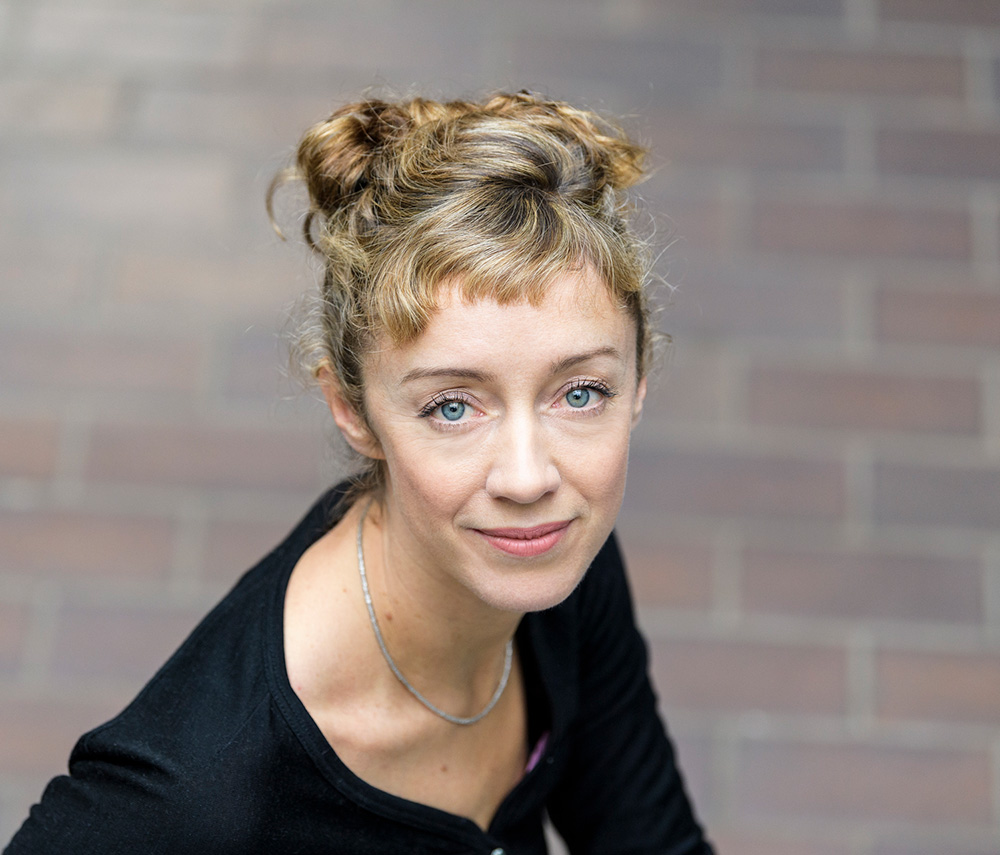
© Foteini Christofilopoulou. (Click image for larger version)
So literally, and this is with Jenny (Tattersall) when I’ve got Jenny with me – she is a huge, huge, part of it. So, she will do research with the dancers – sometimes I will do it but in this one I’ve been making, making, making. Uzma talks to them all before so they’ve been through their character, then Jenny has each character for about half an hour, like even the most minor role… so the spouse of Leopold – with Jenny they found a way of walking, a way of standing and a little phrase, that’s individual to that character. Then I would have everyone in the room, I’d go through all their phrases – I’d already seen it on the video – so that we’d refreshed it a bit. And then I’ll start putting the steps together, or the scene together, and I’ll know dramatically what I need to tell and I’ll share that with them. And I’ll usually say I’m going to have these 4 entering with this bit of music… and then there going to move here etc etc.
So, I’ll have a kind of a structure setup in my head. But in terms of what they are doing they have to remember their vocabulary and I’ll say, “What have you got that can travel over here?” or “Now you are saying hello to Victoria”, how can we do this or that? That’s where Northern Ballet are so good because they are invested in that – they understand. So, they will have at their fingertips, “Well I’m a really forwards person, and then I don’t like her…” They all had to know which their favourite siblings were, which ones they didn’t like… all of these things. Or Albert goes to the military, and another is a sailor… all of these things will inform the choreography. And there is no way that you will know all of those things, but a Victoria scholar will recognise little things if they looked. And the dancers know it and overall it gives a really textured and rich scene. Those two scenes have had a lot of work put into them in different ways.
I’m very prepared and sometimes I will go in if there is a moment where I can give one phrase to a load of dancers all at once. Like the soldiers marching across the stage. But on the whole the movement comes in the studio.
Victoria is a co-production with the National Ballet of Canada – when will it premiere there?
They’ve invested in it even before the UK premiere, which is wonderful. It’s pencilled in for 2021 – we haven’t confirmed a premiere date yet – but its sometime away because they plan very far in advance.
Last year your first work for San Francisco Ballet, Snowblind, was unveiled as part of their Unbound Festival featuring 12 new works in just 2 weeks.
I think Helgi Tomasson’s vision for the festival was brilliant – it was so much fun being there and 7 million dollars, or so, was put into it overall. I think it was a big thing for me – being in that set of choreographers introduced to the States like that.
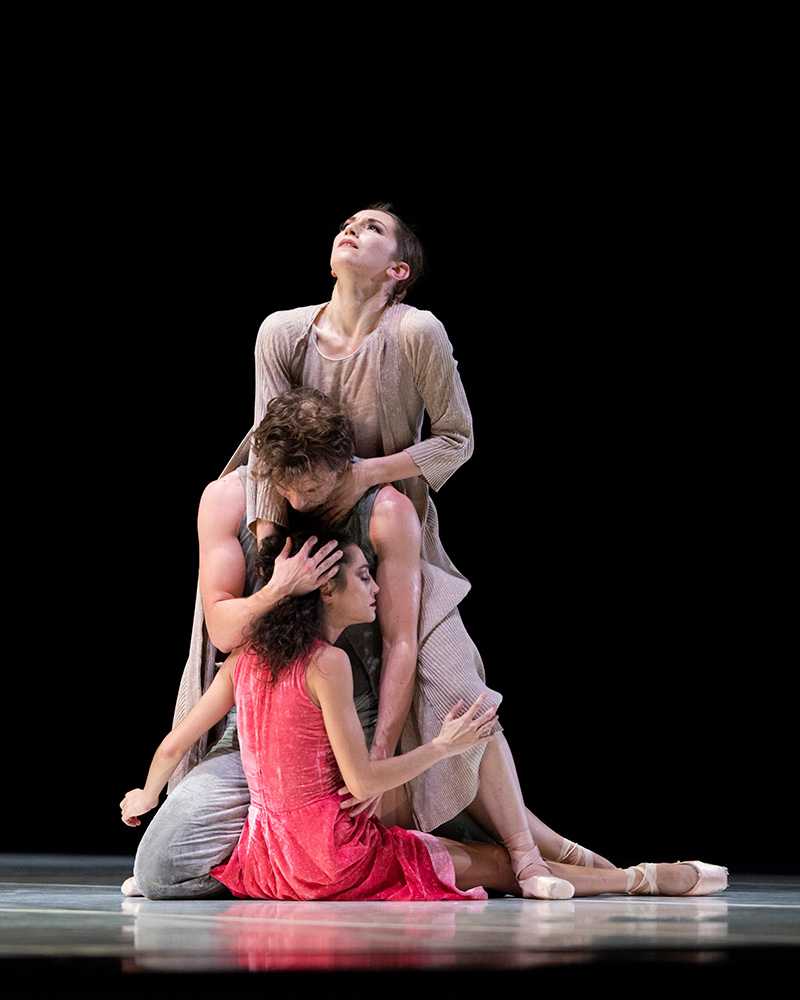
© Erik Tomasson. (Click image for larger version)
And SFB really know how to do it. It was so organised, so well done; those planning it never said no – I don’t know how they did it. Even the technical rehearsals were well planned. There wasn’t a lot of time, but they’d done a good job about warning us about that. And it was all fairly done and then once you’d had the time that was fair, they really sensibly decided which pieces needed what, so maybe some needed more time in the studio, some needed more tech time and they gave you what you needed – I don’t think anyone felt hard done by.
Snowblind got great reviews and has just been reprised in San Francisco and the company are bringing it to London in May/June this year.
Your earlier Northern Ballet work, Jane Eyre, is going to American Ballet Theatre and the Joffrey Ballet – where did that come from?
I was in New York to visit some friends and just tried to meet anyone that I could and saw Kevin McKenzie, the director of ABT. He was very nice, said “I haven’t seen any of your work, but I’ve heard your name and please send me two pieces that you’re proud of, that give an indication of your direction now.” I sent him Jane Eyre and, I can’t remember the other one now, maybe Lolita. And then didn’t hear anything so I though “OK, never mind.” That was in September and then in January, out of the blue I get this email from him Saying “So sorry, only just got time to watch it, but loved it.” And, long story short, because of a season change I was asked if they could do Jane Eyre this year – the NY premiere is 4 June 2019.
And in the week Kevin wrote, completely by chance, the Joffrey’s Ashley Wheater wrote to me as well. I wanted to work with both of them and there didn’t seem to be a really bad touring crossover, so they decided to do it as a co-production. Amazing! The Chicago premiere is on the 1 October 2019.
Are you adjusting Jane Eyre in any way for the larger stages?
A little bit – so it’s been redesigned, not that it’s got a different set so to speak, but obviously the Met (Metropolitan Opera house) is huge and some of the other theatres are big. So, we’ve worked on how we can try to keep the intimacy of it but on a big stage. They wanted to paint it rather than print it, which I think is now going ahead. So, we just made a few adjustments. I don’t know if you remember but there’s a platform at the back of the stage – it was 80 cm wide (quite scary!). Well now it’s a good 2metres. And in terms of the dancers I’m adding 4 orphans because I felt like that scene could take a little more. A few more D-Men just on some of the wild, more organic, scenes. But the party I decided not to because I didn’t want to make it a ball, like a kind of Cinderella style thing. It should be a country house, lonely, moorland thing. So, I decided to keep that as was. So essentially, it’s going to stay the same, with a few little tweaks.
How’s Jane Eyre being set? Is it always you and Jenny Tattersall?
Jenny is at ABT now!
It’s being set by Jenny and Northern Ballet’s Daniel de Andrade, who was in at the creation. David Nixon’s been really good, actually, because I asked him “can you spare someone” and he’s really made it work. That’s what’s lovely actually, the whole of Northern Ballet, especially people like Javier Torres and Hannah Bateman who are the ones really invested in the choreography, are super-proud that it was premiered in Doncaster and it’s going to the Met!

© Justin Slee. (Click image for larger version)
ABT have used some Northern Ballet photos for PR so they keep seeing themselves on Instagram. “We’ve made it to New York!” Vicky Goldsmith said the other day. It’s really nice to get that feeling.
What’s happening at Royal Danish Ballet – you did a great Dangerous Liaisons for them (I was at the premiere and gave it 4 stars)
I think it was very hard after Dangerous Liaisons which was such a wonderful process and both Nikolaj Hübbe and I were thrilled with the premiere night but the local reviews were mixed to say the least. There was a couple that were very good, but on the whole the Danish ones were critical of… partly the idea I think, to mix ballet and theatre and partly they didn’t like the acting.
What’s so hard, I think, was because I had such a good time doing it, but I will never see it and hear as a Danish person. I knew what they were saying, I knew why they were saying it, but I will never receive it in Danish. And so, when you get reviews like that, I couldn’t even argue because it’s just too removed.
I’d love to do it again in English I don’t know where and when I’ll get that opportunity. I would love to see it done in a place, for example Joffrey – Chicago’s got a great theatre tradition or as co-pro between the National Theatre and a ballet company. Something where people don’t go expecting a pure piece of ballet – because it wasn’t that and it wasn’t commissioned as such. Nikolaj’s commission was a piece with theatre and ballet but obviously that hadn’t been communicated thoroughly enough so people came with different expectations – it’s a shame.
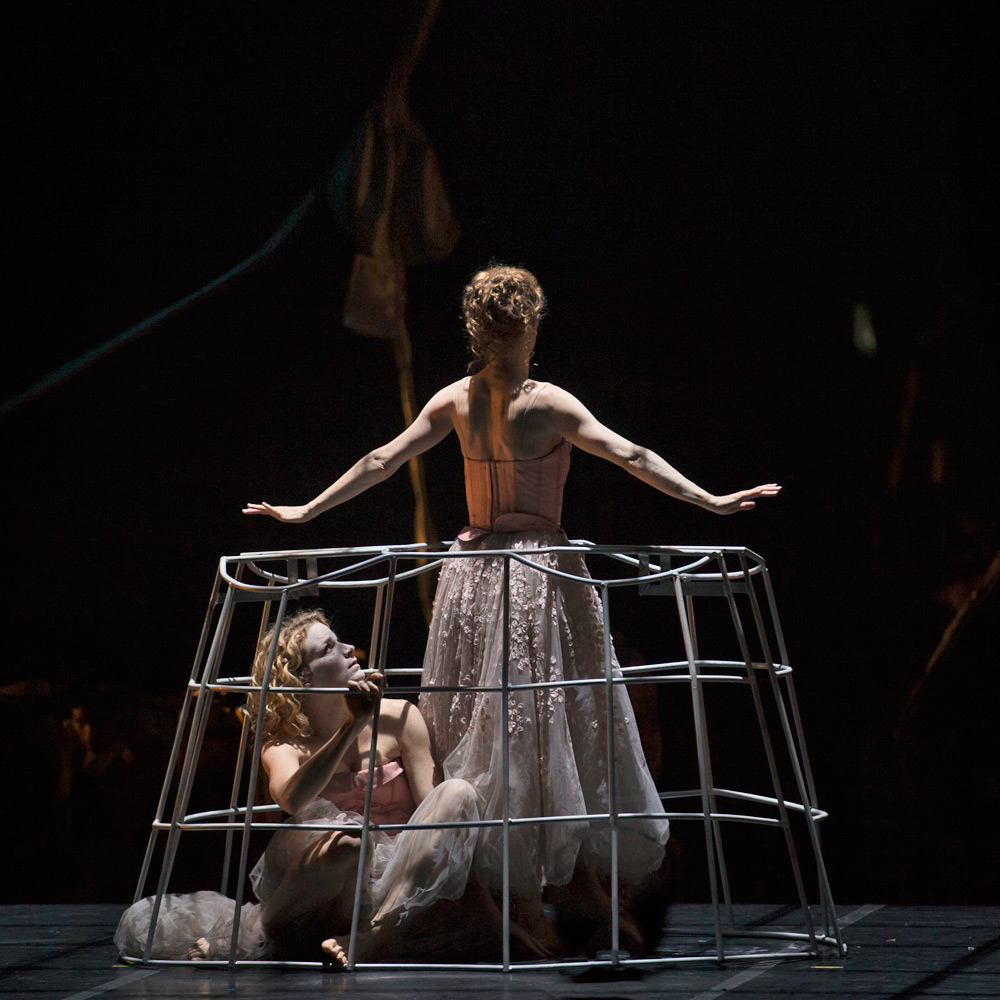
© Costin Radu. (Click image for larger version)
But I don’t want to forget about Dangerous Liaisons because I do think there was a lot of strength and maybe just revisiting it would tighten up some of the things that could be better.
{BM: It’s a terrific piece and it should be seen again}
What have you got coming up?
I have to remember what I can tell you! I’ll tell you about other things but what we can say so far on the record…
- As discussed, Victoria for Northern Ballet is about to premiere and then touring nationally including dates at London’s Sadler’s Wells.
- The Suit has been such a nice thing – great for Ballet Black and it was a lovely experience working with the company. They did well, and I think the story really worked – an idea of Edward Kemp’s. I’m so happy that it’s had such a good reception (and it subsequently won a National Dance Award). And it’s great that The Suite and Ballet Black are going to be part of a Birmingham Royal Ballet programme to be seen at the (Birmingham) Hippodrome and then Sadler’s Wells (Sept/Oct 2019).
- As discussed, San Francisco Ballet are coming to Sadler’s Wells with Snowblind – end of May beginning of June this year.
- As discussed, Jane Eyre for ABT will premiere in June 2019
- As discussed, Jane Eyre for the Joffrey Ballet will premiere in October 2019
I’m really sorry – there is so much going on and you can’t say anything on it yet!
Off the record Cathy tells me about at least 5 other projects, on both sides of the Atlantic, that can’t be announced yet and take her through to 2022. Some should be announced in the next few months as companies outline their plans for 2019/20.
Having directed a small company once (Bern Ballett), do you look to direct a company again at some future time?
I wouldn’t ever say never. And I do like being involved in the conversations and the visioning – I’m not a choreographer that just goes in and only makes a ballet. Right now, it’s not something that I am looking for. But, you know, I’m only 43, it’s quite a long time till retirement still! So, who knows – there might be a time when it does feel right to go back to building something more concrete and in one place. I’ve been on a couple of boards since Bern and that’s been an interesting process. Sadly, I have had to step-off of them both after perhaps not long enough, just because I am travelling so much, and it felt wrong in both cases to keep missing so many of the meetings. But I am interested in maintaining a presence and voice in the wider conversation.
How does it work for you all with family, kids, Bern and working all over?
Gosh! It works, I mean Bret is incredibly supportive and behind the idea. Major piece of advice: Find the right partner. And the children are doing well. I mean they understand, and they come and they visit, they came last summer – they were in Canada for 5 of the 8 weeks. For 3 with a nanny and for 2 with Bret – which was really nice and then they came to Cuba for the last 2 weeks. So they do get an insight into what I am doing. Gilby has already started having crushes on the ballerinas at age 3 and Vivie, like I say, gets really interested in the costumes and with the story and so on.
So, I’m trying to involve them as much as I can, but when they were babies, they came a lot more with me. And I took a nanny around and its less and less possible because of school. But it’s also, in a way, happened well with the timing because now I’m doing intercontinental work rather than just within Europe it’s a big flight thing, it’s a big expense obviously and they’re hyper-active. I mean it was great to have them in Leeds for a week but right now, coming up to the premiere, its wonderful just to be able to concentrate and not have that extra commitment at the end of the day. So, its balanced. And I love freelancing because I can go back to Bern and have some time at home, in between. At the moment it’s working. And Bern is a good place to be based, simply because Bret has a normal job in which he goes to the same place every day and its 5 minutes from home and the schools are good. It feels like everything is contained nicely. It’s not as stressful as I think it would be if we were both in London freelancing – that would be hard going.
Thanks Cathy – I look forward to the Victoria premiere – only wish I could see all the North American ones as well!







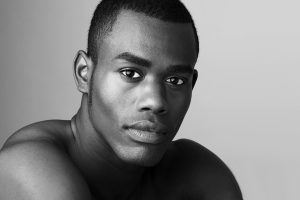
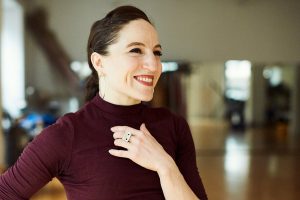




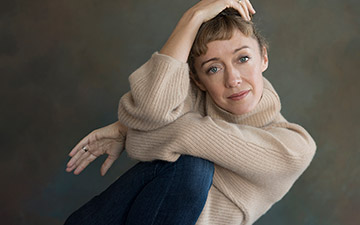
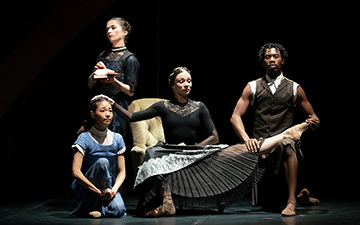


You must be logged in to post a comment.